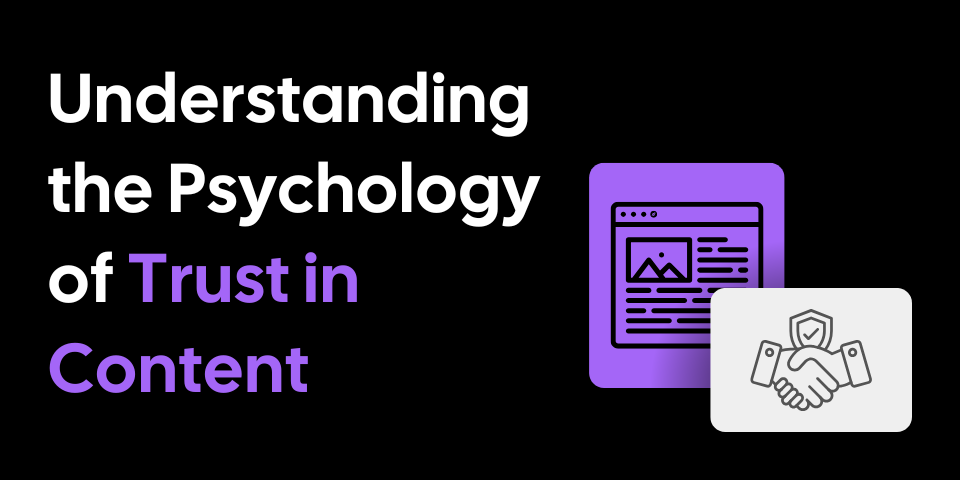
Understanding the Psychology of Trust in Content
Trust turns content from something read into something relied upon. It’s what convinces readers to act, come back, or recommend what they’ve found. Without trust, even the best ideas fall flat.
The Foundations of Trust
Trust is the belief in the reliability, truth, or capability of someone or something. It forms through repeated actions that meet expectations and align with communicated values. At its essence, trust is a process—built over time, reinforced through consistency, and damaged by inconsistency.
For example, in relationships—whether personal or professional—trust erodes when actions deviate from promises, like a missed deadline with no explanation. However, addressing setbacks openly and delivering on revised commitments can rebuild trust and even enhance credibility.
How Trust Engages Readers
When content is trusted, readers don’t just consume it, they connect with it. They see it as relevant, actionable, and worth their time. Trust creates a cycle: readers return, share, and deepen their relationship with your brand.
Imagine an SEO guide that doesn’t just list best practices but illustrates them with step-by-step examples from real-world campaigns. It becomes more than advice; it’s a tool. The depth and clarity transform casual readers into invested followers, fostering loyalty and engagement.
The Psychology of Trust in Content
Authenticity
Authenticity in content fosters trust by creating a sense of relatability and genuine connection. It transforms communication from a transactional exchange into an engaging interaction. When readers perceive the content as sincere and grounded in real experiences or perspectives, they are more likely to trust its intentions and value.
Authenticity also reduces skepticism by aligning messages with genuine values, encouraging readers to feel understood and respected. This approach not only enhances trust but also reinforces long-term engagement.
Actionable Insight: Draw from your own experiences. A relatable example can turn abstract advice into something personal and memorable.
Clarity and Consistency
Clarity ensures readers can easily understand and act on the information presented. Structured, practical advice eliminates ambiguity, empowering readers to take confident steps forward. Techniques like breaking content into clearly labeled sections or using visuals such as charts and bullet points make complex concepts accessible and actionable.
Consistency reinforces this trust by meeting reader expectations regularly. A recognizable tone, reliable quality, and updated content signal a commitment to providing ongoing value. For example, revisiting older material to keep it relevant demonstrates accountability, which strengthens credibility over time.
By combining clarity with consistency, content becomes a dependable resource, encouraging long-term reader engagement and trust.
Strategies for Building Trustworthy Content
1. Make Your Audience the Priority
It begins with understanding. When readers feel that your content speaks directly to their goals and challenges, it builds a natural connection.
How to Apply This:
- Dive into user feedback to uncover unmet needs or frustrations.
- Tailor content to different stages of your audience’s journey, from beginners to experts.
2. Support Every Claim with Proof
Credibility need to be earned. Whether it’s through data, expert insights, or case studies, proof reinforces trust at every level.
Tip: Pair numbers with stories. A testimonial saying “Our traffic increased 50% in three months” becomes far more compelling with a quick walkthrough of the strategies used to achieve it.
3. Design an Intuitive User Journey
Content that’s hard to navigate undermines its value. A seamless reading experience—where links flow naturally and the layout is clear—builds trust by respecting the reader’s time.
How to Apply This:
- Use internal links to guide readers toward related topics, keeping them engaged.
- Optimize page speed and design for usability, ensuring a frustration-free experience.
For instance, having a good internal linking structure not only deepens understanding but also enhances the reader’s journey without disrupting their flow.
4. Be Transparent in Intent
Transparency is a trust multiplier. Readers are more likely to engage when they know why you’re sharing advice and how it serves both them and you.
If a post contains affiliate links, disclose it clearly. Transparency fosters goodwill, turning potential skepticism into confidence.
Avoiding Pitfalls That Undermine Trust
To maintain trust, it’s important to recognize and address common missteps that can erode credibility. The table below outlines key pitfalls, their impact, and actionable solutions to prevent them:
| Pitfall | Impact on Trust | How to Avoid It |
|---|---|---|
| Clickbait Titles | Misleads readers, reducing credibility and discouraging engagement | Align headlines with content and deliver on promises |
| Outdated Content | Signals neglect and decreases perceived value | Regularly review and update content to ensure relevance |
| Overloaded Information | Overwhelmes readers, reducing clarity and engagement | Focus on one core message and simplify complex ideas |
Crafting Trustworthy Content That Endures
Trust it’s earned through consistent, authentic, and transparent actions. Each article, guide, or resource should serve as a building block in your reputation. By prioritizing actionable insights, clarity, and an audience-first approach, you’ll create content that will be remembered, revisited, and shared.
If time is not on your side, streamline that to Tactical Post.Discover how our platform transforms Content Creation from a time-consuming task into an efficient, strategic tool. Whether it’s optimizing Internal Linking or building Topical Authority for your domain, we’ve got you covered.